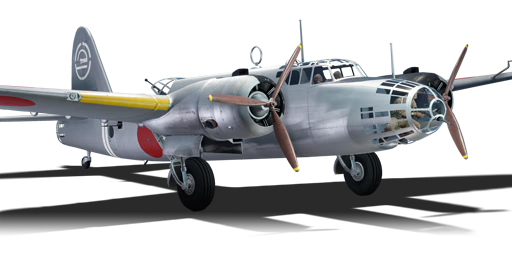

Aviation
Ki-49-I
II
Rank
AB
3.3
RB
3.0
SB
3.7
Battle rating
Japan
Game nation
Bomber
Main role
11,000

Research
22,000

Purchase
General information
The Ki-49-I is a Japanese bomber. It has been in the game since the start of the Open Beta Test prior to Update 1.27. It is the first model of the Ki-49 family in War Thunder. It is notably fast in level flight, features excellent protection from the rear, and is fairly manoeuvrable when making use of its very large elevators. It's the first Japanese bomber to get access to any significant armour protection, and there's plenty of it to be found. Pilots will find the Ki-49 versatile in air battles because of its ability to perform low-altitude bombing as well as bomb bases. Your speed makes up for your payload since you can always make many trips to rearm.
Camouflages
Flight performance
Max speed
at 5,000 m
466433483449 km/h
Rate of Climb
12.510.414.910.4 m/s
Turn time
2930.828.130 s
Max altitude
9,000 m
Takeoff Run
676 m
Landing
flaps
flaps
Take-off
flaps
flaps
Combat
flaps
flaps
Air
brake
brake
General characteristics
Crew
8 persons
Engine
Length
16.8 m
Wingspan
20 m
Wing Loading
140 kg/m²
Weight:
Base weight
7.217.437.057.39 t
Fuel in main tanks
2.45 t (5h 26m)
Limits:
Max Speed Limit (IAS)
580 km/h
Mach Number Limit
0.7 M
G limit
≈ -3/5 G
Flap Speed Limit (IAS)
L / T / C
240 / 364 / 413 km/h
Gear Speed Limit (IAS)
260 km/h
Defensive armament
Turret — 20 mm Ho-1 cannon
Ammunition
200 rounds
Fire rate
400 shots/min
One-second Burst Mass
0.91 kg
| Belt | Belt filling | Armor penetration (mm) at a distance: | |||||
|---|---|---|---|---|---|---|---|
| 10 m | 100 m | 500 m | 1000 m | 1500 m | 2000 m | ||
| FI/HEFI-T/HEF-I/AP-T | 36 | 34 | 25 | 17 | 12 | 8 | |
| AP-T | 36 | 34 | 25 | 17 | 12 | 8 | |
| FI/HEFI-T/FI/HEFI-T | 5 | 4 | 3 | 3 | 3 | 3 | |
5 × Turret — 7.7 mm Te-4 machine gun
Ammunition
2,380 rounds
Fire rate
850 shots/min
One-second Burst Mass
0.15 kg
| Belt | Belt filling | Armor penetration (mm) at a distance: | |||||
|---|---|---|---|---|---|---|---|
| 10 m | 100 m | 500 m | 1000 m | 1500 m | 2000 m | ||
| T/IAI/Ball/AP/AP/I | 13 | 12 | 7 | 3 | 2 | 0 | |
| T/AP/AP/AP | 13 | 12 | 7 | 3 | 2 | 0 | |
| T/AP | 13 | 12 | 7 | 3 | 2 | 0 | |
Suspended armament
Setup 1
12 × 50 kg Army Type 94 GPHE bomb
Setup 2
10 × 100 kg Army Type 94 GPHE bomb
Setup 3
4 × 250 kg Army Type 92 GPHE bomb
Setup 4
2 × 500 kg Army Type 92 GPHE bomb
Setup 5
800 kg Number 80 Mod. 1 bomb
Economy
Repair cost
Basic → Reference
AB
823 → 1,042 

RB
1,418 → 1,795 

SB
2,610 → 3,304 

Crew training
6,300 

Experts
22,000 

Aces
250 

Research Aces
220,000 

Reward multiplier
AB / RB / SB
50 / 120 / 180 % 

124 % 

Total cost of modifications
10,300 

13,780 

Talisman cost
750 

Flight performance | |
|---|---|
Survivability |
|---|
Weaponry | |
|---|---|
Rating by players
You must play more than 3 battles for the last week and more than 10 battles in a vehicle to rate it.
Like:
4
Flight performance:
Not enough ratings
Survivability:
Not enough ratings
Aerial combat:
Not enough ratings
Ground attack:
Not enough ratings
Balance:
Not enough ratings
Tips & Tricks
This space is currently empty
Do you know any interesting vehicle features?
Loading...
No articles about this vehicle yet
Become the first author and get rewards!
Write a guide, tell about interesting historical facts, make a tutorial or simply an interesting post.
No more content